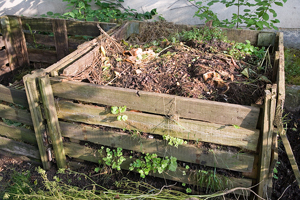We’ve got the cause and solution to all your compost problems.

Cause
Solution
Excess moisture.
Heap too large.
Temperature greater than 55°C.
Compaction.
Too much nitrogen.
Turn the heap to improve drainage and add dry leaves.
Rebuild heap to smaller dimension.
Open heap out and mix in carbon materials (eg, dry leaves, shredded paper, wood shavings, straw).
Turn the heap.
Add carbon-containing materials (eg, dry leaves, shredded paper, wood shavings, straw).
Heap is too dry.
Ants will reform and remix the heap. They do not damage the compost. Wet the compost and the ants will move out.
Small vinegar flies are a natural part of the compost process and cause no real harm. House flies are also a natural part of the decomposition process, but they cause more nuisance and may transmit disease.
Tolerate vinegar flies if possible as they contribute to the compost process. To reduce house flies, cover organic wastes with a thin layer of soil or mature compost. Avoid adding meat, fish, dairy food or manure wastes.
Heap too large.Reduce windrow size.
|
Problem
|
|
ANAEROBIC ODOUR |
|
ANTS |
|
FLIES |
| HIGH TEMPERATURE |
LOW TEMPERATURE
Heap too small.
Insufficient moisture.
Poor aeration.
Combine heaps to make larger.
Water the heap.
Turn the heap to incorporate air.
MAGGOTS
Meat, fat, fish waste or faeces.
Remove the cause, cover maggots with lime and cover the heap with a layer of soil. Turn the heap and make it larger and hotter.
RODENTS
Using meat and vegetable scraps without sufficient burying.
Rats may build homes in a warm winter heap.
Rats in plastic bins.
If rats invade compost, turn and repack the heap. Ensure food wastes are buried deeply. Do not add meat waste. If rats are persistent, cease adding vegetable scraps.
Use traps or baits, or encourage cats or dogs to hunt.
Bury bins in soil. Line bases with aviary wire.
SLOW DECAY
The pile may be too small or the compost-to-nitrogen balance may be incorrect.
Lack of oxygen.
Not enough water.
Too much water.
Too cold in winter.
Increase the size of the heap by adding more material. Add more nitrogen (eg, blood and bone).
Turn heap to incorporate air; use slotted conduit or other methods to get air in.
The heap should be moist but not sodden. Water the heap with a gentle spray.
Turn the heap to improve drainage; add dry leaf matter to absorb excess moisture.
Cover the heap with carpet or hessian or make the heap larger. Use hot manures such as poultry, as it’s high in nitrogen and sugars. Insulate with straw biscuits.
SPIDERS
Natural part of the compost process.
Wold spiders and other ground-dwelling hunting spiders often live in compost, so tolerate them as much as possible. Web-making spiders, including redbacks, may nest under the lid of plastic compost bins or on worm farms. Use a handle on the lid, wear gloves and check under the lid before handling. Brush webs and spiders away. Remember that spiders kill many plant pests.
SOGGY, WET COMPOST
Too much rain.
Too much irrigation.
Cover the compost heap with tarpaulins or plastic sheets.
Turn the heap to improve drainage and add dry leaves. Leave the heap open during the day to increase drying and turn the heap over slowly for several hours.




